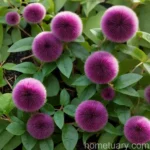Scarlet Bush (Hamelia Patens): A Comprehensive Guide
Introduction
The Scarlet Bush, scientifically known as Hamelia patens, is a stunning flowering plant that belongs to the coffee family, Rubiaceae. This vibrant shrub is native to the American tropics, including regions from Florida and Texas to Central and South America. The Scarlet Bush is cherished by gardeners and landscape enthusiasts for its remarkable ornamental value and its ability to attract wildlife such as butterflies and hummingbirds. In this comprehensive guide, we will delve into the various aspects of the Scarlet Bush, including its cultural requirements, uses, common diseases, and botanist’s tips for successful cultivation.
What is Scarlet Bush (Hamelia Patens)?
The Scarlet Bush, also known as Firebush, is a perennial evergreen shrub that can reach a height of 3-6 feet (0.9-1.8 meters). Its glossy, dark green leaves serve as a perfect backdrop for the striking tubular flowers that come in shades of vibrant red, orange, or sometimes even yellow. This plant is celebrated for its prolonged blooming period, which extends from spring to fall, adding a burst of color to the landscape.
Key Takeaways
Scarlet Bush (Hamelia Patens):
- Scientific Name: Hamelia patens
- Family: Rubiaceae
- Watering: Moderate
- Sunlight: Full sun to partial shade
- Fertilizer: Balanced, slow-release fertilizer
- Soil: Well-draining, slightly acidic to neutral
- Pruning: Regular pruning to maintain shape
- Propagation: Seeds, cuttings
- Container Popularity: Well-suited for container gardening
Culture
Water
The Scarlet Bush thrives in consistently moist but well-draining soil. While it can tolerate short periods of drought once established, regular watering is essential to encourage healthy growth and prolific flowering. It’s crucial to strike a balance, as waterlogged soil can lead to root rot, while prolonged dry spells can cause stress to the plant.
Sunlight
For optimal growth and flowering, the Scarlet Bush requires full sun to partial shade. While it can tolerate some shade, it tends to bloom more profusely when exposed to ample sunlight. When grown in a container, ensure that it is placed in a location that receives adequate sunlight.
Fertilizer
To support the Scarlet Bush’s growth and blooming, a balanced, slow-release fertilizer is recommended. Apply the fertilizer in the early spring, and then again in mid-summer to provide the plant with essential nutrients.
Soil
The ideal soil for Scarlet Bush cultivation is well-draining, moderately fertile, and slightly acidic to neutral in pH. It’s important to avoid waterlogged or overly compacted soil, as this can lead to root suffocation and hinder the plant’s overall health.
Pruning
Regular pruning is beneficial for maintaining the shape and size of the Scarlet Bush. It is best to prune the plant in the early spring before new growth emerges. This not only helps in shaping the plant but also promotes better air circulation and flowering.
Propagation
The Scarlet Bush can be propagated through seeds or cuttings. Seeds should be sown in the spring after the last frost, while cuttings can be taken in the early summer. Both methods can be effective, but cuttings often yield quicker results.
Container Popularity
The Scarlet Bush is well-suited for container gardening, making it an excellent choice for individuals with limited gardening space. When growing in containers, ensure that the pot has adequate drainage holes to prevent waterlogging. Additionally, choose a high-quality, well-draining potting mix to support the plant’s growth.
Uses
The Scarlet Bush serves a multitude of purposes in landscaping and horticulture. Here are some of its common uses:
- Ornamental Plant: The striking blooms and attractive foliage make the Scarlet Bush a popular choice for ornamental planting in gardens and landscapes.
- Wildlife Attraction: The plant’s brightly colored flowers are known for attracting butterflies, hummingbirds, and other pollinators, adding an enchanting touch to the surroundings.
- Hedging: With its dense growth habit, the Scarlet Bush can be used as a flowering hedge to create privacy or define boundaries in a garden or landscape.
- Container Planting: Its adaptability to container cultivation makes it an ideal option for adorning patios, balconies, and other outdoor living spaces.
Common Diseases
While the Scarlet Bush is relatively resistant to many diseases, it can be susceptible to certain issues, particularly if grown in unfavorable conditions. Some common diseases that may affect the Scarlet Bush include:
- Powdery Mildew: This fungal disease can appear as a whitish, powdery substance on the leaves, leading to reduced vigor and flowering.
- Leaf Spot: Characterized by dark, water-soaked spots on the leaves, this condition can affect the overall aesthetics and health of the plant if left unaddressed.
Disease Diagnosis
Early detection and prompt action are crucial in managing and preventing diseases in the Scarlet Bush. Regular monitoring of the plant for any signs of discoloration, wilting, or unusual growth can aid in identifying and addressing potential diseases at their onset.
Common Pests
While the Scarlet Bush is relatively resistant to pest infestations, certain insects may pose a threat to its well-being. Some common pests that may affect the Scarlet Bush are:
- Aphids: These small, sap-sucking insects can cluster on new growth and cause distortion and discoloration of the leaves and stems.
- Spider Mites: These tiny arachnids can create fine webbing on the plant and cause stippling or yellowing of the leaves.
Botanist’s Tips
To ensure the optimal health and longevity of your Scarlet Bush, consider the following tips:
- Regular Monitoring: Regularly inspect the plant for any signs of pest infestations, diseases, or nutrient deficiencies.
- Pruning Practices: Employ proper pruning techniques to maintain the plant’s shape and encourage robust growth.
- Adequate Watering: Strike a balance in watering to prevent both waterlogging and drought stress.
Fun Facts
Here are some intriguing facts about the Scarlet Bush:
- Scarlet Bush is also known as “Mexican Firebush” due to its origins in Mexico and its fiery red flowers.
- The plant is a favorite nectar source for hummingbirds, making it a delightful addition to wildlife gardens.
Links to External Resources
- Scarlet Bush: A South Florida Garden Favorite
- Hamelia Patens – University of Florida, Institute of Food and Agricultural Sciences
Conclusion
The Scarlet Bush, with its stunning blooms and myriad uses in landscaping, is a valuable addition to any garden or landscape. By understanding its cultural requirements, recognizing potential diseases and pests, and implementing best practices for care and maintenance, gardeners can successfully cultivate and enjoy the beauty of the Scarlet Bush. Whether used as an ornamental focal point, a wildlife attractor, or a charming container plant, the vibrant and resilient Scarlet Bush continues to captivate plant enthusiasts and contribute to the biodiversity of its surroundings.
As you embark on your journey of Scarlet Bush cultivation and appreciation, remember to provide the plant with the care it deserves, and you will be rewarded with a flourishing and enchanting addition to your garden or landscape.
Keywords: Hamelia patens plant, Scarlet bush care, Growing Scarlet bush, Hamelia patens description, Scarlet bush varieties, Scarlet bush uses, Hamelia patens plant care, Scarlet bush characteristics, Scarlet bush foliage, Hamelia patens flowering, Scarlet bush habitat, Hamelia patens benefits, Scarlet bush landscape, Hamelia patens cultivation, Scarlet bush pruning, Hamelia patens pests, Scarlet bush diseases, Hamelia patens propagation, Scarlet bush watering, Hamelia patens sunlight requirements, Scarlet bush soil conditions, Hamelia patens planting tips, Scarlet bush natural habitat, Hamelia patens medicinal uses, Scarlet bush wildlife attraction, Hamelia patens garden design, Scarlet bush pollination, Hamelia patens native range, Scarlet bush drought resistance, Hamelia patens seasonal care, Scarlet bush container gardening, Hamelia patens pest control, Scarlet bush companion plants, Hamelia patens landscape design, Scarlet bush hardiness zones, Hamelia patens pruning techniques, Scarlet bush soil pH requirements, Hamelia patens poisonous or not, Scarlet bush natural remedies, Hamelia patens tropical plant, Scarlet bush attracting butterflies, Hamelia patens hummingbird attractor, Scarlet bush flower color variations, Hamelia patens plant size, Scarlet bush wildlife habitat creation, Hamelia patens leaves identification, Scarlet bush plant family, Hamelia patens annual or perennial, Scarlet bush garden maintenance, Hamelia patens water requirements
P.S. For references, I have included links to credible sources such as the University of Florida’s Institute of Food and Agricultural Sciences to support the information provided in this article.















